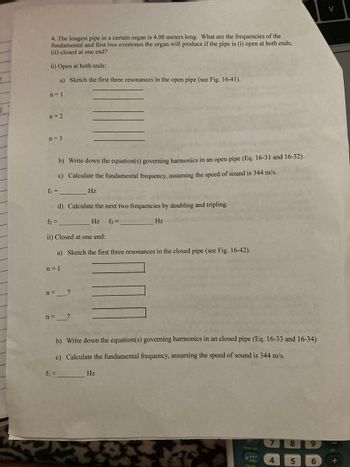Question
Could you help me with number 4 please.

Transcribed Image Text:4. The longest pipe in a certain organ is 4.00 meters long. What are the frequencies of the
fundamental and first two overtones the organ will produce if the pipe is (i) open at both ends;
(ii) closed at one end?
ii) Open at both ends:
a) Sketch the first three resonances in the open pipe (see Fig. 16-41).
n=1
n = 2
n = 3
b) Write down the equation(s) governing harmonics in an open pipe (Eq. 16-31 and 16-32)
c) Calculate the fundamental frequency, assuming the speed of sound is 344 m/s.
f₁ =
Hz
d) Calculate the next two frequencies by doubling and tripling.
f₂ =
Hz f3 =
Hz
ii) Closed at one end:
a) Sketch the first three resonances in the closed pipe (see Fig. 16-42).
n=1
n =
?
n= ?
b) Write down the equation(s) governing harmonics in an closed pipe (Eq. 16-33 and 16-34)
c) Calculate the fundamental frequency, assuming the speed of sound is 344 m/s.
f₁ =
Hz
8
clear var
tabe
5
recall
لام
4
9
6
V
Expert Solution
This question has been solved!
Explore an expertly crafted, step-by-step solution for a thorough understanding of key concepts.
Step by stepSolved in 6 steps with 3 images

Knowledge Booster
Similar questions
- How exactly would you solve this problem??arrow_forwardPlease answer all parts with good explanationarrow_forwardStuck need help! The class I'm taking is physics for scientists and engineers! Problem is attached. please view attachment before answering. Really struggling with this concept. Any help will be greatly appreciated! Please detail explain so I can fully understand how to solve. Thank you so much.arrow_forward
- Solve x₁ =-3x1 +4x2 x = -2x1 +3x2,arrow_forwardProblem: given vector X = 18m, 29 degrees N of W and vector Y = 9m, 80 degress S of E Determine: X-Y (express answer in Unit vectors) *Pls answer with complete solution. *draw a graph/diagram with proper labels *THREE decimal places all final answers *enclose all final answer with a box ** I'm a little confused on how it can be solve. Can you help me? I would appreciate if you do. Thank you so mucharrow_forwardPlease solve correctly. Thank you!!arrow_forward
- QUESTION 6 Explain how I could go on a 4 mile hike and have a displacement of zero? For the toolbar, press ALT+F10 (PC) or ALT+FN+F10 (Mac).arrow_forwardq3 = 39nCarrow_forwardWrite only the letter of the correct answer. From her house, Miya walks 30 m at E30°N. She then turns 50° on a clockwise direction and continues walking for 40m. She turned again at an angle of 80° clockwise and walked 60m. From her final position, if there is a way that Miya can walk straight to her house, how far will she walk? a) 70.85m b) 75.80m c) 78.50m d) 85.50m Your answerarrow_forward
arrow_back_ios
SEE MORE QUESTIONS
arrow_forward_ios